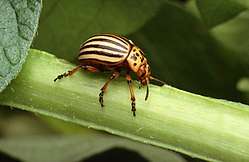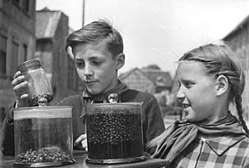War against the potato beetle
The war against the potato beetle was a campaign launched in Warsaw Pact countries during the Cold War to eradicate the Colorado potato beetle (Leptinotarsa decemlineata). It was also a propaganda operation that alleged that the insect was introduced into East Germany, the People's Republic of Poland and Communist Czechoslovakia by the United States as a form of entomological warfare. Communist propaganda of the time claimed that the insect was being dropped from parachutes and balloons, with the intent of immiserating the populations of these countries, causing famines, and facilitating an economic crisis.[1]

The beetle

The Colorado potato beetle, also known as the "ten striped spearman", is a common pest of potato crops. It is most likely native to the area between Colorado and northern Mexico, and was discovered in 1824 by Thomas Say in the Rocky Mountains. Since the mid-nineteenth century, it has been one of the most destructive pests of the cultivated potato. The insect made its way to Germany in the 1870s but was successfully eradicated. However, it made a second appearance after World War I in the Bordeaux area in France, where it probably arrived with American troops and equipment.[2] It reached the French border with Germany by 1936 and continued spreading eastward.[3] It was probably transferred to Czechoslovakia with the German occupation after the Munich agreement and to Poland after the Nazi invasion in 1939.
The most common method of dealing with the pest is through the use of pesticides. DDT was effectively used until the bug developed resistance by the 1950s. Subsequently, other insecticides were employed but these eventually ran into a similar problem.
Before the Cold War
While later Cold War-era allegations were propaganda, the idea of using the beetle for purposes of warfare had factual origins. During World War I, the French did actually draft plans for using the potato beetle against the Germans and in turn, during World War II, Germany worked on developing an insect army of its own, while simultaneously alleging that such a program was being carried out by the United States and the British.[3]
During the Cold War
Soviet Union
The Colorado beetle crossed the borders of the Soviet Union in 1949, but Soviet authorities were able to quickly eradicate it, and strict quarantine restrictions managed to prevent its spread, but only until 1958.[4] After that, the beetle spread widely across USSR, greatly affecting potato crops on the collective farms and small individual plots. The latter were affected especially severely, since in USSR the private small farmers and gardeners lacked access to officially distributed effective pesticides, so the beetle, their eggs, and larvae often had to be collected by hand - often a chore assigned to children.
German Democratic Republic

After World War II, nearly half of all potato fields in the Soviet-occupied zone were infested by the beetle by 1950. In East Germany in the 1950s, the insect came to be known as "Amikäfer", a neologism for "Amerikanischer Käfer" (the "American beetle"). Propaganda posters were issued that depicted the beetle marching across Germany, with its yellow and black stripes replaced by red and white ones with white stars on a blue background on the thorax.[1] Other posters showed the beetle being dropped from American planes with the caption "Kampf für den Frieden" ("The battle for peace"). A letter was issued to "the people of the world", stating that "the beetles are smaller than the atomic bomb... but they are also a weapon of the US imperialists in the fight against the peace-loving workers and peasants of East Germany." Children's books on the beetle were also published and "Sondersuchtage" ("Special Search Days") were organized in which everyone from young children to the elderly was expected to come out and gather the pests for destruction.[5]
The communist authorities were aware, however, that the presence of the potato beetle on socialist German soil was not an American plot. An internal report of the East German Ministry of Agriculture attributed the increase in the number of pests after the war to the favorable climate and the straightforward migration of the insect from the west.[5]
People's Republic of Poland
In Poland, the war against the potato beetle (stonka) began in the second half of the 1940s. Articles on the plague appeared in major newspapers and farmers' magazines such as Przysposobienie Rolnicze i Wojskowe ("Agricultural and Military Almanac"). The official organ of the ruling communist Polish United Workers' Party Trybuna Ludu ("People's Tribune") reported that after being dropped on the Baltic Sea by American planes, the beetle emerged onto land and began to wage "sabotage and diversionary actions aimed at socialist Poland". As a result, the communist government declared a "merciless war against the beetle". A Naczelny Nadzwyczajny Komisarz ("General Special Commissar") was appointed to oversee the assault on the beetles, the country was divided into strategic sectors, and battle maps indicating enemy positions were drawn up. Simultaneously, instructions were issued to farmers describing simple and effective ways of eradicating the pest if pesticides were not available; for instance drowning specimens in water with a small admixture of kerosene. Even Poland's socialist poets joined the struggle, exemplified by Maria Kownacka's poem Alarm, which instructs farmers to "protect the potatoes!!!" and tells either the beetle or the imperialists that "we will not let ourselves to be starved!!!" (exclamation marks in original).[6]
A Polish newsreel from 1950, "Walka z stonką" ("The struggle against the beetle"), claimed that "the progressive opinion of the world has rightfully condemned the crimes of the American pilots who dropped tremendous amounts of the potato beetle on the fields of the German Democratic Republic... from where the beetle invaded Polish territory". The news report went on to describe the campaign launched by the Polish Ministry of Agriculture to eradicate the pest through the use of DDT (Azotox in its Soviet bloc version), vigilance on Poland's Baltic coast, engagement of the Polish Air Force, and the general mobilization of society, particularly the youth. The newsreel concluded that "the American pest will be unsuccessful both in Poland and Germany. The warmongers' provocation will crash and burn. Everyone to war against the beetle!"[7]
In a 1951 book published by the Polish Ministry of Defense, Zofia Kowalska wrote that American planes dropped beetles, "violating sovereign airspace", on the night of 24 May in East Germany, in the Zwickauer Land of Saxony.[8]
In Poland, the propaganda campaign associated with the beetle ended by the beginning of the 1960s.
Western response
In response to the allegations issued by the Soviet bloc countries' governments, the US issued tepid denials.[5] In August 1950, at the suggestion of the CIA, the West German authorities printed postcard-sized cardboard replicas of the potato beetle and stamped these with political slogans and the letter "F" for "Freiheit" ("Freedom"). A number of these were sent to all the municipal governments in East Germany and the rest dropped from a balloon over East German territory as a joke.[9]
Modern era
In the European Union, the beetle remains a regulated (quarantine) pest for the United Kingdom, the Republic of Ireland, the Balearic Islands, Cyprus, Malta and southern parts of Sweden and Finland. It is not endemic in any of these member states, although occasional infestations occur, as in Finland in the summer of 2011, when strong winds blew from Russia.[10][11]
References
- Lockwood, Jeffrey A. (2008). Six-Legged Soldiers: Using Insects as Weapons of War. Oxford University Press. p. 136. ISBN 0199743886.
- Lockwood, Jeffrey A. (2008). Six-Legged Soldiers: Using Insects as Weapons of War. Oxford University Press. p. 407. ISBN 0199743886.
- Leitenberg, M.; Zilinskas, R. A.; Kuhn, J. H. (2012). The Soviet Biological Weapons Program: a history. Harvard University Press. p. 408. ISBN 0674065263.
- Insect Pests of Potato: Global Perspectives on Biology and Management edited by Andrei Alyokhin, Charles Vincent, Philippe Giordanengo page 14
- "Kartoffelkäfer". Landwirtschaft. Chronik und Dorfbuch Widdershausen. Retrieved 21 October 2013.
- Daszkiewicz, Alicja (29 November 2006). "Desant stonki". Edukacja i szkolenie. Farmer.pl Portal Nowoczesnego Rolnika. Retrieved 22 October 2013.
- Walka z stonka (War against the beetle) (Film). Wytwórnia Filmów Dokumentalnych. 1950.
- Kowalska, Zofia (1951). Stonka ziemniaczana. Ministerstwo Obrony Narodowej (Ministry of National Defense, Poland).
- Körner, Klaus. "Politische Broschüren im Kalten Krieg". "SBZ von A-Z" - gesamtdeutsche Broschüren?. Deutsches historisches Museum. p. 4. Retrieved 22 October 2013.
- Koloradonkuoriainen hyppyyttää tarkastajia perunapelloilla YLE news (in Finnish)
- Herrmann, Bernd (2009). "Schauplätze und Themen der Umweltgeschichte : Umwelthistorische Miszellen aus dem Graduiertenkolleg". ISBN 9783941875234. Cite journal requires
|journal=(help)